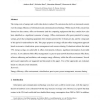TON
2010
13 years 7 months ago
2010
In this paper we study several ways in which mobile terminals can backoff on their uplink transmit power in order to extend battery lifetimes. This is particularly effective when a...
CN
2010
13 years 9 months ago
2010
The rising costs of energy and world-wide desire to reduce CO2 emissions has led to an increased concern over the energy efficiency of information and communication technology. Wh...
ICCAD
2009
IEEE
13 years 10 months ago
2009
IEEE
While Dynamic Voltage Scaling (DVS) remains as a popular energy management technique for real-time embedded applications, recent research has identified significant and negative i...
CCE
2004
14 years 12 days ago
2004
A heat-integrated prefractionator arrangement is studied for a ternary separation of a propane
TWC
2008
14 years 13 days ago
2008
In this letter, we are concerned with adaptive ARQ techniques combined with backoff strategies that exploit the bursty nature of wireless links for improved energy savings. Specifi...
JCP
2007
14 years 13 days ago
2007
When the environmental conditions are stable, a typical Wireless Sensor Network (WSN) application may sense and process very similar or constant data values for long durations. Thi...
IJES
2007
14 years 14 days ago
2007
: Compiler support for power and energy management is effective in reducing power and energy consumption of programs. Compilers typically take single programs as input without the ...
CN
2006
14 years 18 days ago
2006
Energy saving is a paramount concern in wireless sensor networks (WSNs). A strategy for energy saving is to cleverly manage the duty cycle of sensors, by dynamically activating di...
SAC
2010
ACM
14 years 23 days ago
2010
ACM
Dynamic configuration techniques such as DVFS (Dynamic Voltage and Frequency Scaling) and turning on/off computers are well known ways to promote energy consumption reduction in w...
MOBICOM
2010
ACM
14 years 23 days ago
2010
ACM
Cellular radios consume more power and suffer reduced data rate when the signal is weak. According to our measurements, the communication energy per bit can be as much as 6x highe...

